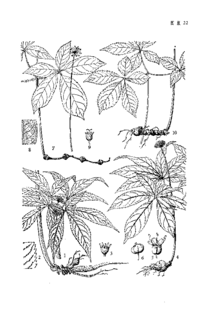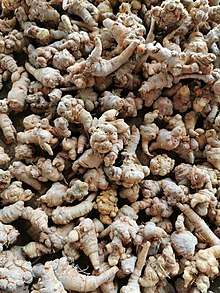Panax notoginseng
Panax notoginseng is a species of the genus Panax, and it is commonly referred to in English as Chinese ginseng[2] or notoginseng. In Chinese it is called tiánqī (田七), tienchi ginseng, sānqī (三七) or sanchi, three-seven root, and mountain plant. P. notoginseng belongs to the same scientific genus as Panax ginseng. In Latin, the word panax means "cure-all", and the family of ginseng plants is one of the best-known herbs.
| Notoginseng | |
|---|---|
 | |
| Botanical illustration | |
| Scientific classification | |
| Kingdom: | Plantae |
| Clade: | Tracheophytes |
| Clade: | Angiosperms |
| Clade: | Eudicots |
| Clade: | Asterids |
| Order: | Apiales |
| Family: | Araliaceae |
| Genus: | Panax |
| Species: | P. notoginseng |
| Binomial name | |
| Panax notoginseng (Burkill) F.H.Chen[1] | |

P. notoginseng grows naturally in China. The herb is a perennial with dark green leaves branching from a stem with a red cluster of berries in the middle. It is both cultivated and gathered from wild forests, with wild plants being the most valuable. The Chinese refer to it as three-seven root because the plant has three petioles with seven leaflets each. It is also said that the root should be harvested between three and seven years after planting it.
Chinese medicine
In traditional Chinese medicine, P. notoginseng is classified as warm in nature. The taste is sweet and slightly bitter. A decoction of 5-10 g is a typical dose. It can also be ground to a powder for swallowing directly or taken mixed with water. The dose in that case is usually 1-3 g.[3]
Chemical components
P. notoginseng contains dammarane-type ginsenosides as major constituents. Dammarane-type ginsenosides includes 2 classifications: the 20(S)-protopanaxadiol (ppd) and 20(S)-protopanaxatriol (ppt) classifications. P. notoginseng contains high levels of Rb1, Rd (ppd classification) and Rg1 (ppt classification)ginsenosides. Rb1, Rd and Rg1 content of P. notoginseng is found to be higher than that of P. ginseng and P. quinquefolius in one study.[4]
See also
References
- "Panax notoginseng (Burkill) F.H.Chen". Plants of the World Online. Royal Botanic Gardens, Kew. Retrieved 10 January 2020.
- "2016-nyeon insam tonggye-jaryo-jip" [Source book of ginseng statistics 2016 (in Korean)]. Ministry of Agriculture, Food and Rural Affairs (in Korean). May 2017. pp. 2–4. Retrieved 24 February 2018. Lay summary (7 June 2017).
- Dan Bensky, Steven Clavey, Erich Stoger, and Andrew Gamble (2004). Chinese Herbal Medicine: Materia Medica (Third ed.).CS1 maint: multiple names: authors list (link)
- Shu Zhu; et al. (2004). "Comparative study on triterpene saponins of ginseng drugs". Planta Medica. 70 (7): 666–677. doi:10.1055/s-2004-827192. PMID 15303259.
| Wikispecies has information related to Panax notoginseng |